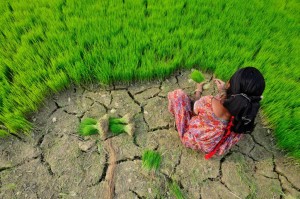Category : News
Published : July 30, 2013 - 3:22 PM
Most plant breeders and genetic resources scientists would agree that crop wild relatives as a rich source of exotic diversity have proved their worth in contribution to crop improvement, especially for pest and disease resistance. So it may come as a surprise that despite their long history of use in breeding major crops, many CWR species are not well collected and conserved in genebanks. Meanwhile their native habitats are increasingly threatened by development and climate change, among other factors. Why this disjunct between estimated value and adequate protection?
Though scientists appreciate the value of CWR, it appears that conservation groups, policymakers, and the general public are not as well informed about the unique potential hidden within these wild and weedy plants. How can information on the value of CWR improve? One of the most persuasive forms of communication about the issue is, of course, monetary value.
A recent analysis commissioned by Kews Millennium Seed Bank Partnership (MSB), and carried out by PricewaterhouseCoopers (PwC), UK, has taken the latest stab at evaluating the economic benefit of use of CWR.
By using current and forecasted gross production values from the Food and Agriculture Organization of the United Nations (FAO), the study estimated the current value of commercial crops grown today, and in the future, containing improved productivity or stress resistance traits derived from CWR.
Results based on four crops- wheat, rice, potato, and cassava- were extrapolated to a group of 29 crops prioritized by the MSB Partnership (the same crops targeted by our gap analysis1) and assigned values based on analyses from seed development to farm-gate sales. Based on current production, the CWR of the target crops were assigned a value of $42 billion, with a potential of $120 billion in the future.
The annual GPV of the 29 priority crops was $581 billion in 2010, meaning that CWR are already valued at about 7% of annual production value.
Stephen Aherne, director, PwC adds, While the findings in our analysis are indicative, the overall message is clear. CWRs represent a valuable tool in global crop development for many organisations related to the agriculture sector Our research underlines the need for further investment in CWR collection and research, without which the significant potential value to global agriculture may not be realised.
-
The 29 crops and their wild relatives targeted by the Project, are covered by Annex 1 of the International Treaty on Plant Genetic Resources for Food and Agriculture (ITPGRFA). They are: African rice (Oryza glaberrima), alfalfa (Medicago sativa), apple (Malus domestica), eggplant (Solanum melongena) , bambara groundnut (Vigna subterranea), banana (Musa acuminata), barley (Hordeum vulgare), carrot (Daucus carota), chickpea (Cicer arietinum), common bean (Phaseolus vulgaris), cowpea (Vigna unguiculata), faba bean (Vicia faba), finger millet (Eleusine coracana), grasspea (Lathyrus sativus), lentil (Lens culinaris), lima bean (Phaseolus lunatus), oat (Avena sativa), pea (Pisum sativum), pearl millet (Pennisetum glaucum), pigeonpea (Cajanus cajan), plantain (Musa balbisiana), potato (Solanum tuberosum), rice (Oryza sativa), rye (Secale cereale), sorghum (Sorghum bicolor), sunflower (Helianthus annuus), sweet potato (Ipomoea batatas), vetch (Vicia sativa) and wheat (Triticum aestivum).

